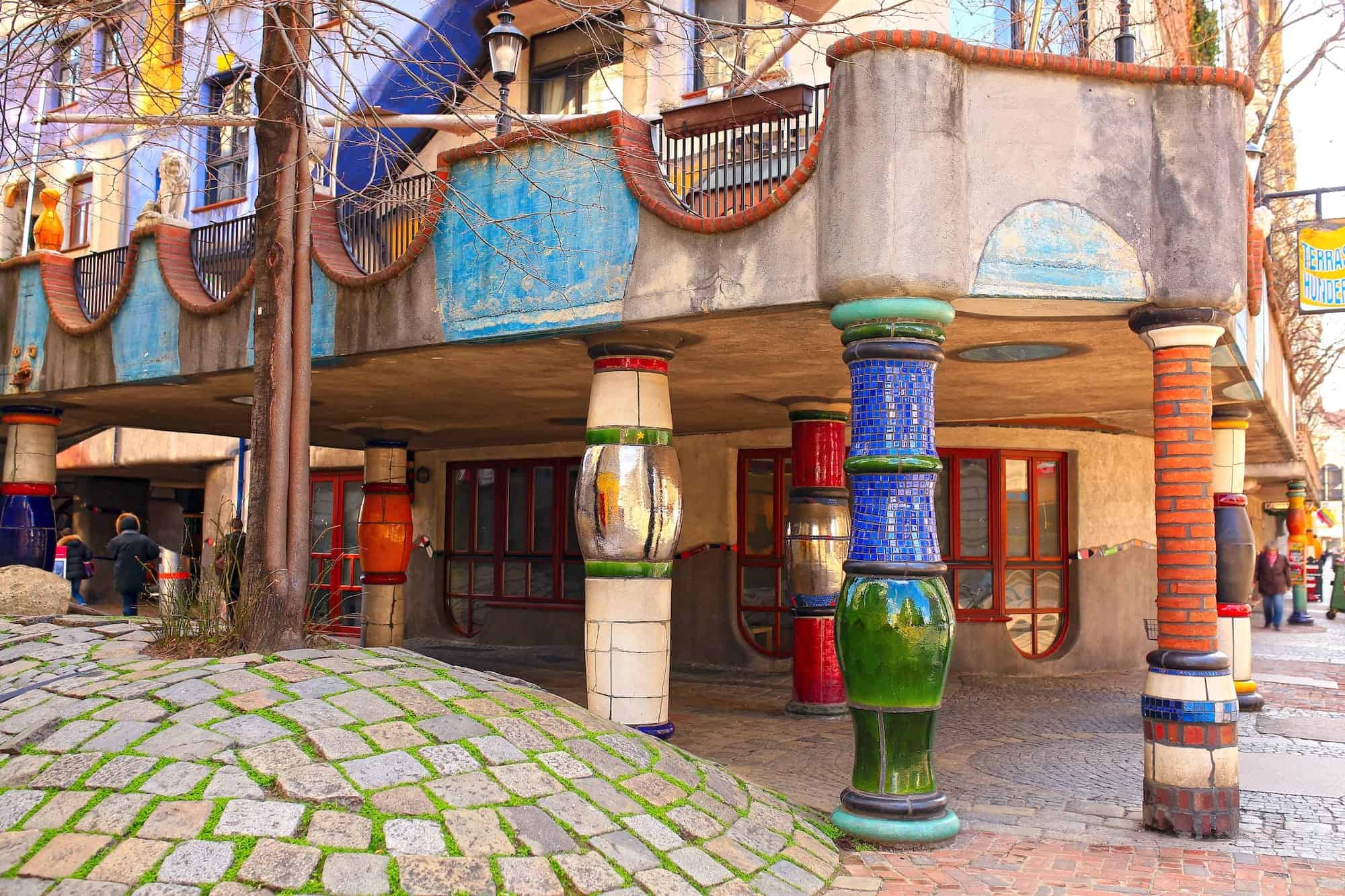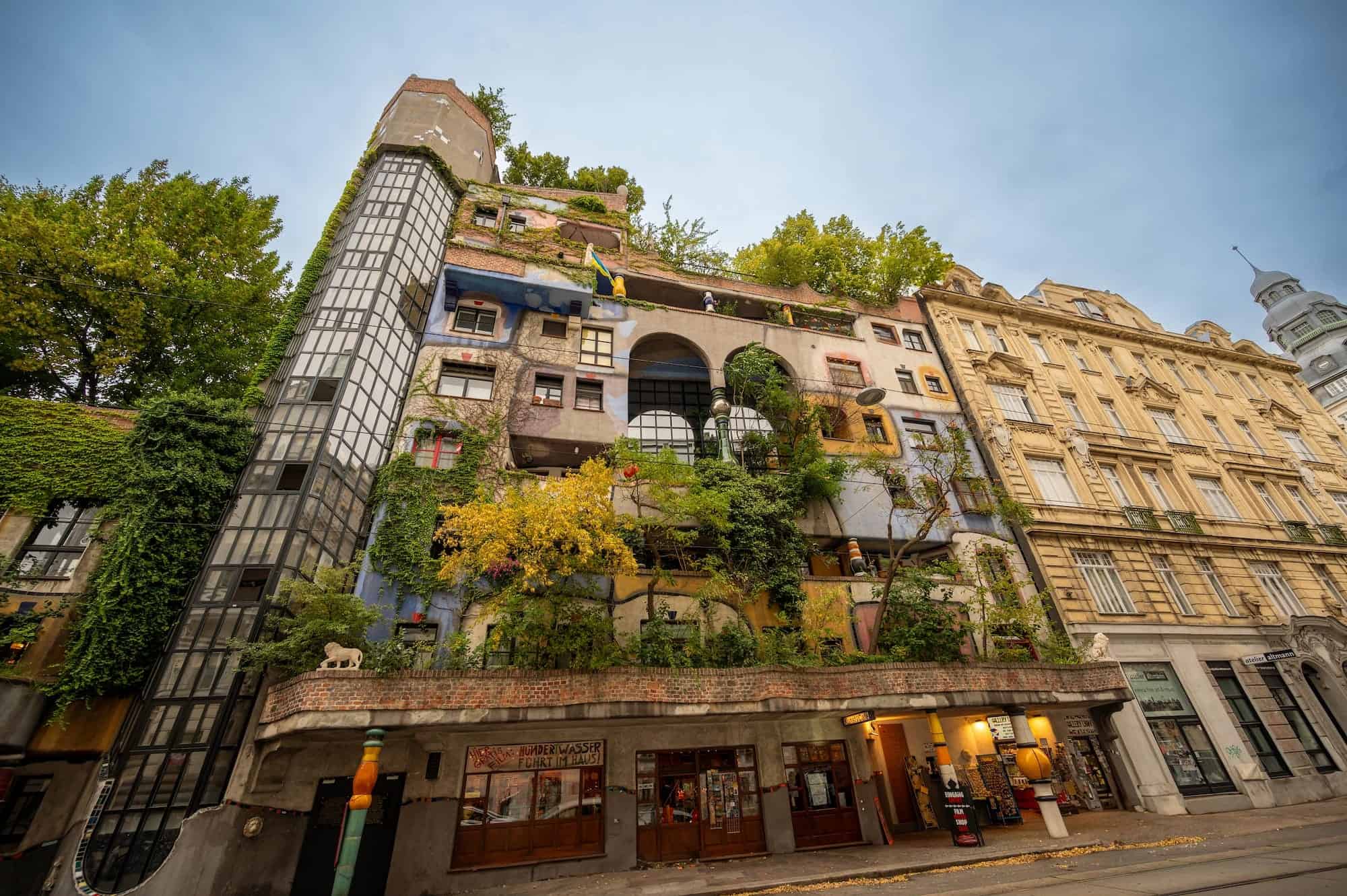As you wander through Vienna’s narrow streets, a building suddenly emerges before you, as if plucked from the pages of a fairy tale. Vividly colored facades, winding lines, and greenery everywhere—it’s as if nature and architecture have formed a pact here. This is the Hundertwasserhaus, one of Vienna’s most photographed landmarks and a prime example of how art and functionality can seamlessly blend together.
Built in the 1980s as a social housing complex, the Hundertwasserhaus is now an architectural icon. It is the life’s work of Austrian artist Friedensreich Hundertwasser, who fought against dull, straight lines and advocated for organic forms and a deeper connection with nature. His vision? Cities should breathe again, buildings should not exude monotony, and residents should feel part of their environment.
Although the building cannot be visited from the inside, it attracts thousands of visitors annually who come to admire the playful forms and vibrant colors. In the immediate vicinity, you’ll find the Hundertwasser Village and the Kunst Haus Wien, where you can delve deeper into the world of this unconventional artist. But what makes the Hundertwasserhaus so special? And why has this building, which once faced much resistance, now become one of the city’s most beloved spots?
Who was Friedensreich Hundertwasser?
Friedensreich Hundertwasser (1928-2000) was an Austrian artist, architect, and environmental activist known worldwide for his colorful and organic designs. Born as Friedrich Stowasser, he deliberately chose to change his surname—”Sto” means “hundred” in Russian, leading to the name Hundertwasser.
From a young age, Hundertwasser developed a distaste for the strict, symmetrical architectural styles that increasingly dominated cities. He believed that buildings should not be sterile and rectilinear but should merge with nature. This idea later became the foundation of his architectural philosophy: buildings with undulating lines, green roofs, and a strong connection between humans and their environment.
In addition to architecture, Hundertwasser was intensely involved in painting and environmental awareness. He was an advocate for ecological building techniques, material reuse, and sustainable living. His designs often featured trees growing out of windows, uneven floors (“people must feel that they are walking and not floating”), and colorful mosaics.
Hundertwasser was controversial in the architectural world. His playful, almost anarchistic style clashed with the functional, minimalist building trends of his time. Nevertheless, through his unique vision, he garnered a large following of admirers. The Hundertwasserhaus in Vienna, designed in collaboration with architect Josef Krawina, became one of his most famous works and is today one of the city’s most recognizable buildings.
Beyond the Hundertwasserhaus, he left his mark on various other structures in Austria and abroad, including the Kunst Haus Wien, the Bad Blumau spa, the Hundertwasser Bahnhof Uelzen in Germany, and the Maishima Sludge Center in Osaka, Japan. His ideals and designs continue to influence the world of sustainable architecture even after his death.
The construction and architecture of the Hundertwasserhaus

In the 1970s, the city of Vienna sought to develop a new housing complex. Friedensreich Hundertwasser was given the opportunity to influence the design and seized it wholeheartedly. His vision? A building that would not become a cold concrete block but a lively, organic place where humans and nature converge.
Collaborating with architect Josef Krawina, who oversaw the technical execution, Hundertwasser began construction in 1983. Two years later, the project was completed. The result: a playfully designed housing complex that starkly contrasts with traditional urban architecture. Undulating facades, asymmetrical windows, and lush greenery make it one of Vienna’s most striking buildings.
What makes the Hundertwasserhaus special?
- Uneven floors and walls: Straight lines and monotonous forms are entirely absent. No two spaces are identical, giving the whole an organic character.
- Nature as an integral part: More than 200 trees and shrubs grow on the roofs and balconies, allowing the building to breathe and change with the seasons.
- Expressive colors and mosaics: The facade is a vibrant artwork in itself, where blue, yellow, red, and green come together unpredictably.
- The “window rights”: Hundertwasser proposed that residents could modify and decorate their windows as they wished, allowing them to leave their personal mark on the exterior.
Despite initial skepticism from the architectural community, the Hundertwasserhaus has become an icon. It demonstrates that a housing complex can be more than functional; it can be a statement, an artwork that evokes emotions and inspires.
Visiting the Hundertwasserhaus

The Hundertwasserhaus is one of Vienna’s most notable buildings, but unlike many other attractions, it cannot be viewed from the inside. This is because it is a residential complex where people actually live. To respect the privacy of the inhabitants, the apartments remain closed to the public. Nevertheless, a visit is worthwhile, as even from the outside, the building offers plenty to admire.
Best times to visit the Hundertwasserhaus
- Early in the morning or late in the afternoon – These times are less crowded and provide the best lighting conditions for photography.
- Outside the peak season (spring or autumn) – In summer, many tourists visit this spot, making it harder to admire the building in peace.
- During an architecture walking tour – Several guided tours in Vienna focus on Hundertwasser and his influence on the city.
The Hundertwasserhaus is more than just a landmark; it’s a living work of art that invites you to experience architecture differently. Even without stepping inside, it leaves a lasting impression.
Practical information for your visit
Although the Hundertwasserhaus cannot be visited from the inside, it remains a popular attraction in Vienna. With proper planning, you can make the most of your visit and easily combine it with other sights in the city.
Location & Accessibility
- Address: Kegelgasse 36-38, 1030 Vienna
Public transport:
- Tram 1 (stop: Hetzgasse) – Just a few minutes’ walk from here.
- Metro U3/U4 (stop: Landstraße) – About a ten-minute walk.
- Bus 4A (stop: Rasumofskygasse) – Located right near the building.
The Hundertwasserhaus is situated in Vienna’s 3rd district, just outside the historic center. From the Innere Stadt (the city center), it takes about 15 minutes by public transport to reach the site.
Best spots to photograph the Hundertwasserhaus
Due to the compact surroundings, capturing the entire building in one shot can be challenging. The best spots for photos are:
- Across the street, where you can get a good view of the colorful façade.
- The corner of Löwengasse and Kegelgasse, where the playful shapes and greenery are beautifully visible.
- The elevated terrace at Hundertwasser Village, which provides a unique perspective on the building.
Food & drinks nearby
There are several charming cafés and restaurants near the Hundertwasserhaus where you can take a break after your visit. Some recommendations:
- Café Kunst Haus Wien – Located at the Kunst Haus Wien, featuring a cozy courtyard in true Hundertwasser style.
- Joseph Brot – An artisanal bakery offering excellent coffee and freshly baked bread.

